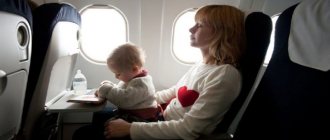The upcoming flight with a baby on an airplane causes excitement and many questions among young parents: how to prepare for the flight, whether to buy a ticket or not, how much you need to pay for a child’s ticket, at what age can a baby fly and how will the baby cope with the trip. For it to go well, all questions that arise must be sorted out before the flight in advance.
How flying can affect your health
Most airlines have a ban on flying with a newborn under 7 days old.
One of the dangerous factors for a baby is the pressure difference during takeoff and landing. Even adults feel discomfort at this moment. This affects the work of the auditory (Eustachian) tube, which balances the difference in pressure in the middle ear cavity and the environment. If the auditory tube does not cope with this function, pain is felt in the ears, and hearing deteriorates (up to its temporary loss). In a newborn, this can lead to inflammation of the auditory tube and the development of otitis media.
A common cold in a child, and even more so the pronounced symptoms of ARVI, themselves worsen the functioning of the auditory tube, so there is a high probability that otitis media will develop after the flight. Doctors do not recommend transporting babies even with a slight runny nose.
Another harmful factor that affects the condition of small passengers is low air humidity on board. During a long flight, the nasal mucosa may dry out.
Important! To make breathing easier for children, irrigate the nasal passages with special solutions.
A child cries during takeoff
When traveling with a child, you should consider not only the impact of the flight, but also the consequences of sudden climate change. Visits to hot countries in winter have a special impact. It should be taken into account that acclimatization at the resort takes 2-3 days. And if the trip only lasts a week or less, returning to the cold can lead to a lingering cold even in an adult, let alone a child. It is advisable to vacation with your child at sea for at least two weeks.
Airline conditions for flying with a baby
Airlines have conditions under which it is permissible to take an infant on board the aircraft, as well as recommendations on the course of action when being in the cabin with him. To understand how to fly with a baby on an airplane, you need to check the information on the website and additionally consult with the flight attendant upon boarding the plane before departure.
The rules for flying with an infant on any airline state that:
- It is necessary to inform the airline about traveling with an infant when purchasing tickets.
- Infants under the age of 5 or 6 months, during takeoff and landing, as well as turbulence zones, are always in the arms of mom or dad for their safety and are fastened to an adult’s belt using special fasteners.
- The baby should be in the arms of an adult, with his head in the direction of the porthole.
Free carriage of bassinets and car seats on board is allowed.
The ability to use a carrycot or car seat for infants is provided if it is certified for flights on an airplane and the passenger has purchased an additional seat for it
Airliner toilets have a changing table, and large planes have a separate room for mother and child and play areas.
At what age can you fly?
Longest flight on an airplane
For the reasons described, caution should be exercised when planning a flight with infants.
If circumstances force you to fly earlier than a week after birth, parents will be required to sign a document in which the airline declines responsibility for the health of the baby.
If 7 days have passed since birth, the little passenger will be accepted onto the plane without additional formalities. But parents are advised to first make sure that their child can fly on an airplane. After an examination, the pediatrician will determine from how many months it is safe for the baby to travel by air.
At what age to fly?
The behavior and well-being of each little passenger is individual, but there is some pattern:
- It is easier for children under six months to fly when they sleep most of the time and are not too sensitive to extraneous noise;
- From six months to a year it is more difficult to fly: the child sleeps less, he is already bored of just sitting in his arms, but he still cannot focus on one activity for a long time. The baby will show curiosity or anxiety in an unfamiliar environment, so you will have to keep him occupied with something all the way;
- Children from one to two years old can already become interested in toys or cartoons for a long time, so it is easier to distract them from the whims and activities that disturb other passengers.
Ticket price
Why do you dream of flying on an airplane?
The cost of children's tickets is determined by the airline. As a rule, one adult can transport one child under 2 years of age throughout Russia free of charge without providing him with a separate seat. In this case, a child's ticket is required. When flying abroad, you may need to pay up to 10% of the full price, even if the baby flies in the arms of an accompanying person.
If a passenger is traveling with several children, for the rest it is necessary to buy a ticket at the child fare (for different carriers it is 50-75% of the adult fare).
Passengers with children
Airlines adhere to strict rules regarding the age of children: if the trip coincides with the second anniversary, you should be especially careful when buying tickets. If you turn two years old the day before or on the day of departure, then round trip tickets must be purchased at the rate for children 2-12 years old. If the birthday was on a trip, then only the return flight is paid at an increased rate.
Registration
Cost of accompanying a child on an airplane
When flying with children, it is better to check in online as soon as it opens. This will allow you to choose convenient seats and fly the whole family together. If this is not possible, then at the airport check-in counter you should ask for comfortable seats. Carriers have rules that require priority when boarding passengers with children. But if the plane is full, there is a possibility that only the mother and child will be placed in the safe seats at the front of the cabin, while the accompanying persons (including the father) will be in other places. When checking in at the airport, passengers with children must be allowed to skip the line.
Children without documents are not allowed to fly. On domestic flights, you must present your birth certificate upon boarding. When traveling abroad - a small passenger's international passport. If the child is accompanied by a third party, a notarized permission from the parents or guardians may be required for the child to travel abroad.
What documents are needed
When preparing for a flight, several basic documents must be prepared for your child, regardless of his age.
List of documents for a 2-month-old baby:
- birth certificate as the main document proving his identity and belonging to one or another parent;
- a positive decision on the possibility of flying approved by a pediatrician;
- permission from the second parent for the child to fly, certified by a notary, if he is traveling with only one of them, or the consent of the guardian, if the child is flying unaccompanied;
- international passport;
- visa for the child, if required by the host country.
To pass control, it is important to take the originals of the child’s documents
Takeoff and landing
The most unpleasant moments for a baby are takeoff and landing. It's better when he sleeps at this time. If you can’t put the child to sleep, he is restless or cries a lot, you should try feeding him or giving him a pacifier. Swallowing movements will help relieve spasm of the auditory tube and reduce discomfort. For the same purpose, it is recommended to put vasoconstrictor drops in the baby’s nose before takeoff. Their choice should be discussed in advance with your pediatrician.
Feeding on takeoff
All passengers must wear seat belts during takeoff and landing, as well as in the landing zone. A special seat belt is issued for the child, which is attached to the adult’s belt.
Feeding your baby during the flight
Low atmospheric pressure at cruising altitudes increases the pressure in the infant's intestines. Eating and sucking, in this case, can add more air to the baby's already bloated intestines and cause colic and tummy pain. Therefore, try to feed the baby just before takeoff and make sure that he burps well. If there is a need to feed your baby during the flight, then offer him to eat little and often, and make sure that he burps well.
Taking baby food in hand luggage is allowed. The amount of dry nutritional mixtures and cookies in hand luggage is not regulated. It is better to pack jars of baby food in transparent bags for convenience during customs inspection. It is better to buy special water for your child. Closed baby water is passed everywhere without problems.
The flight attendant will always bring warm water for milk powder or porridge upon your request.
Flying with a stroller
Each airline independently determines its children's baggage allowance. If you are bringing a stroller with you, check in advance whether it can be transported in the cabin. As a rule, strollers are picked up at the time of boarding. It’s better to find out when you can use it again: sometimes they are brought to the gate, but more often they are unloaded along with their luggage onto a conveyor belt or at the oversized baggage counter.
Flying with a baby stroller
For children under 2 years old, strollers are carried free of charge in addition to the children's free baggage allowance (10-15 kg per child in different airlines). If the child is older, the weight of the stroller will be included in the free baggage allowance.
The stroller will definitely be inspected, so you shouldn’t load it with things. Some airlines allow you to take a folding cane stroller into the cabin if it fits into the standard dimensions. Others only allow the stroller to be used until boarding, and then transport it to the luggage compartment. You are only allowed to take the carrycot from the stroller into the cabin.
For flying with a baby, a book stroller is more suitable. The baby can either lie or sit in it, it is convenient to guide it with one hand, and it can be folded quickly and compactly.
As an additional service on board, carriers can equip their airliners with special cradles that are attached to the partitions between cabins. This service is free, but it is better to arrange it in advance.
Special cradles on the plane
Psychological preparation of mom and dad before flying with an infant
The mother or parents of a two-month-old baby, first of all, need to understand that the child may cry, and there will be scandalous people among the passengers. They can be understood: no one wants to hear the baby crying all the way. In addition, it is unlikely that a tired passenger will be able to fall asleep in such an environment.
Preparing parents for flying with a baby:
- Anxious parents should take mild sedatives in advance. It is known: the calmer the parents, the calmer their children. If quarrels in the family are the norm, you should agree that no matter what happens during the flight, the family will put up immediately, without raising their voices in the cabin and, thus, without disturbing the peace of other people. Otherwise, nervousness and tension will be transferred to the baby, as a result of which he will begin to cry and it will be difficult to calm him down.
- Dads who like to fly without children and allow themselves to drink alcohol will have to give it up and take care of their baby when flying with their family. There should not be situations where the mother alone tries to calm the baby, and the father watches TV or plays with gadgets.
The responsibility for competent handling of the child in the aircraft cabin lies with the parents. It is important to consult in advance with a pediatrician and other parents, for example, on forums or thematic communities about methods of calming the baby during the flight.
What to take on board
Baby food and water
During personal search and search of hand luggage, passengers may be asked to leave bottles of liquid at the airport - this is a security requirement. An exception is made for children - they are allowed to take baby food and water on board (the required amount for the flight) with a total volume of no more than a liter. The child needs to drink more on the plane because the air in the cabin is dry. Some carriers offer special children's menus on board upon prior request.
Care items
The comfort and well-being of the baby is the key to a smooth flight. The toilets on almost all planes are equipped with changing tables, so hygiene procedures for babies can be carried out right in the cabin. To be prepared for any situation, you will need the following set:
- diapers;
- wet and paper napkins;
- bib (if you feed baby food);
- disposable diapers;
- a few pacifiers.
Cloth
The baby must wear comfortable clothes and a spare set is required. Additionally, you will need warm clothes or a blanket (plaid) - it is usually cold on the plane due to ventilation. Warm clothes will come in handy if you have to go outside straight from the plane to get to the terminal.
Activities for children
Activities for children
If you can fly light with a one-month-old baby and hope that he will sleep the whole way, then for older children you will have to think about leisure time. Toys, books, cartoons on a tablet (smartphone), etc. will come in handy. You may have to keep your child's attention all the way so that he doesn't get capricious and disturb other passengers.
First aid kit
When traveling on an airplane, you need to take first aid supplies for your child, tested or recommended by a doctor:
- remedies for abdominal pain and colic;
- means for normalizing stool;
- painkillers and antipyretics;
- vasoconstrictor drops;
- disinfectants: bandage, cotton wool, cotton swabs.
How to put to bed
If your baby has a favorite thing that helps him fall asleep faster, then it’s worth taking it with you on the plane. Such items are often children's pillows, soft toys, blankets, etc. When parents try to put the baby to sleep, it is necessary to remove all items that serve as entertainment.
For a child who is already one year old, you can buy a special pillow-collar that helps maintain the head in a comfortable position while sleeping. To protect a falling asleep child on an airplane from light, you can stretch a blanket between the backs of the seats, creating a kind of canopy.
As you can see, traveling on an airplane with a one-year-old child or infant is not at all scary. When setting off on a trip, you just need to familiarize yourself with the rules for transporting small passengers on an airplane and not forget the necessary documents and everything that parents and their baby may need.
Proximity with other passengers
Travelers with children, in addition to caring for the child’s health, have to worry about how their relationships with others on the plane will develop. Infants may begin to be capricious or cry out loud, and it is very difficult to calm them down. In this case, dissatisfied or even aggressive passengers will add stress for parents. The task of the flight attendants in this case is to “resolve” the situation, perhaps by moving nervous neighbors away from the family with the baby. You shouldn’t get into conflict; usually children feel their mother’s nervous tension and this can make them cry even more.
Staff care
From what age does it take to fly with a baby on an airplane? This is a decision for each individual family. But at any age, traveling with a small child must be carefully organized. It is important for parents not to get confused and understand what to expect from each stage of the trip.
Preparation begins even before purchasing plane tickets - you should study the rules for flying with children from suitable companies, they can differ fundamentally. The main points are check-in, seat selection, baggage allowance, carriage of strollers and meals on board.
In general, the staff is very child-friendly, as airlines fight for customer loyalty. Comfortable flight conditions have been created for children and their accompanying passengers, and on board the flight attendants provide attention.











